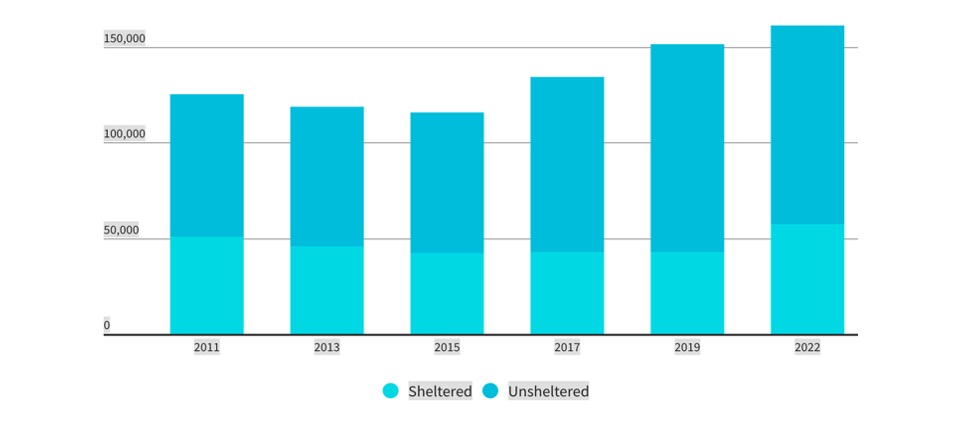Comments
PLANNING WATCH - Three new homeless studies rebut the frequent “blame the victim” claims concocted by the urban growth machine and its supporters:
- Homelessness is caused by mental illness and drug addiction. No, most people with severe mental illness are not unhoused, and many people who are unhoused succumb to mental illness and/or drug use after they become homeless.
- Homelessness is caused by people moving from cold areas to sunny California, especially Los Angeles. No. Three-quarters of the unhoused are local.
- Homelessness is caused by people who voluntarily choose to live on the streets or in a car. No, the homeless grew up in a house or apartment, and economic conditions forced them to become unhoused. Few of them impulsively decided to live outside.
- Homelessness is a police problem. Homeless is not a crime, and the police can only harass the unhoused to the point they relocate elsewhere.
The best of these new studies is from the University of California’s San Francisco medical school (UCSF): Toward a New Understanding: The California Statewide Study of People Experiencing Homelessness. This study determined that the main cause of homelessness in California is financial: “Even if the cause of homelessness was multifactorial, participants believed financial support could have prevented it. Seventy percent believed that a monthly rental subsidy of $300-$500 would have prevented their homelessness for a sustained period; 82% believed receiving a one-time payment of $5,000-$10,000 would have prevented their homelessness; 90% believed that receiving a Housing Choice Voucher or similar option would have done so.”
The second study is from the Los Angeles Homeless Service Authority’s (LAHSA) 2023 Greater Los Angeles Homeless Count. The LAHSA report documents that homelessness increased 9 percent in Los Angeles County and 10 percent in the city of Los Angeles over the past year. One of the report’s findings stands out :“The City and the County are on track to create approximately 8,200 affordable homes this year, but all of the leaders acknowledge the need for more affordable housing.” This is LAHSA’s politically adroit way to acknowledge that LA’s unhoused population grew faster than local programs could house them.
The third study was in the June 19, 2023, Wall Street Journal: Homeless Numbers rise in U.S. Cities. The paper reported, “Rising housing costs and the limited supply of affordable apartments are major factors contributing to homelessness around the country . . .” What the paper identifies as national trends certainly applies to California.
As good as these studies are in documenting the increasing numbers of unhoused people, they do not adequately examine the causes of the growth trends they describe. Like the country as a whole, in California homelessness has steadily increased since 2014, when the Great Recession finally ended.

While these developments are carefully documented in the LAHSA and Wall Street Journal studies, even rigorous studies, like the UCSF one, failed to answer the obvious questions. Why is homelessness increasing, and what can be done about it? Here are my answers:
Cause #1) Elimination of public housing: A major reason for the decline in the number of affordable housing units is the termination of the Federal government’s HUD (Department of Housing and Urban Development) public housing programs, beginning in the early 1970s. An obvious response is the restoration of the Federal government’s public housing programs. This won't be cheap, and I could only find one detailed proposal for this, in Senator Sanders 2020 presidential campaign platform.
In California there is a second cause, the State Legislature dissolved all local redevelopment agencies in 2011. The State had required them to spend 20 percent of their budgets on public housing, and this legislative action eliminated a second source of funding. While older public housing still exists, like Ramona Gardens in Los Angeles, it was built over 50 years ago.
The national and local alternative to public housing is the crackpot theory that profit-driven private sector developers will build unprofitable low-priced housing. This approach, including local density bonuses ordinances, has failed to reduce homelessness, as documented in the three studies I linked to.
Cause #2) Rampant real estate speculation: A second financial approach is taming the "urban growth machine" through a vacancy tax and an end to the variances and zone changes that City Hall automatically grants to luxury, high-rise apartments.
Cause #3) Decline in real wages: In Los Angeles a tenant needs to earn $39/hour to rent a typical two bedroom apartment. Since the average salary in LA is $33/hour, many people fall through the cracks. Furthermore, inflation has widened this gap, pricing more people out of the private housing market. Some of them join the ranks of the unhoused.
Cause #4) False claims about zoning and a housing shortage: City Hall’s responses to the housing crisis make conditions worse, not better. A perfect example is LA’s 2021-2029 Housing Element. Its implementation through citywide upzoning increases property values and causes rents, housing prices, and homeless numbers to rise. This is why these upzoning programs need to be jettisoned.
The reason why these four causes of the housing crisis are glossed over in otherwise excellent studies is the misuse of the public sector to enrich private real estate speculation. Until this changes, the number of unhoused, overcrowded, and rent-gouged people will continue to grow.
(Dick Platkin is a retired Los Angeles city planner who writes about local planning issues for CityWatchLA. He is a board member of United Neighborhoods for Los Angeles (UN4LA). Previous Planning Watch columns are available at the CityWatchLA archives. Please send any questions to [email protected].)
















